The Oppo A74 5G is another budget phone that pushes 5G connectivity to the fore. However, while it’s a competent all-rounder, it fails to stand out against its rivals in any other regard.
Pros
- 5G connectivity
- Solid fingerprint sensor
- Relatively clean software
Cons
- Mediocre performance
- Slower charging than some rivals
- Only a 90Hz LCD panel
-
ScreenThis screen here refreshes at 90Hz -
Network skillsThis is a 5G phone, so can take advantage of faster data speeds
Introduction
The Oppo A74 5G is another in an increasingly long line of affordable phones offering 5G connectivity at a £250 (or thereabouts) price tag.
It’s a neat and tidy cheap phone that handles the basics with minimal fuss. However, as ever at this end of the market, the provision of 5G represents a point of compromise as much as it does a positive feature.
Contemporaries include the Samsung Galaxy A32 5G, the OnePlus Nord N10 5G, and the Nokia X10. More recently in 2022, we’ve seen the launch of the Poco M4 Pro 5G and the Realme 9 5G at the same RRP.
So what, if anything, can Oppo do to make a statement in such a closely fought field?
Design and Screen
- Plastic but solid build
- Reliable fingerprint sensor
- 90Hz and FHD+ LCD
The Oppo A74 5G design is deeply by-the-books. Don’t expect any of the occasionally eye-catching flourishes of Xiaomi’s Poco line here.
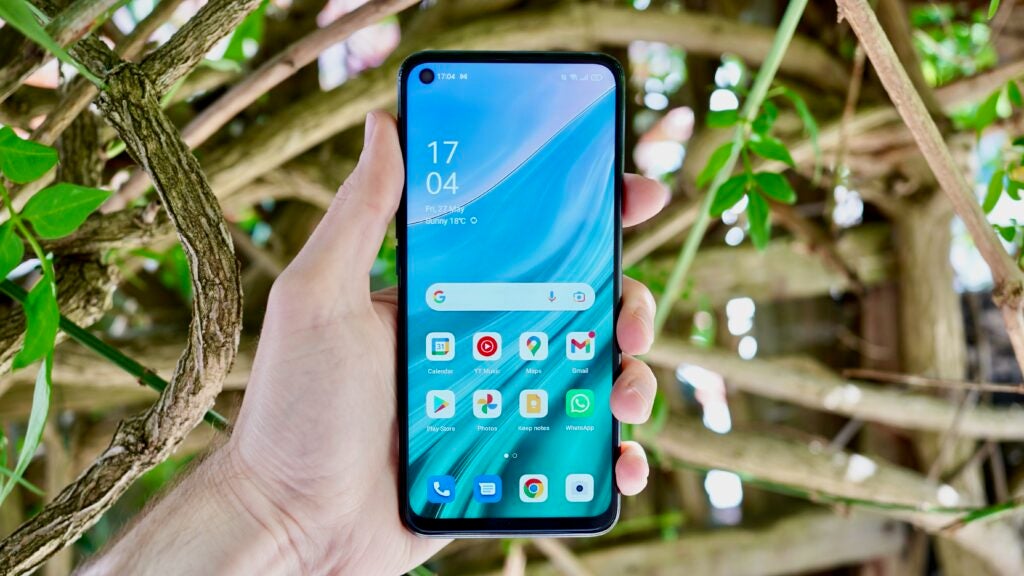
Like most other budget Oppo phones, it’s easy to hold, with a rounded back and sides and regular 162.9 x 74.7 x 8.4mm dimensions. It weighs 190g, which is the right side of heavy.
The phone doesn’t feel remotely premium, however. Its shiny plastic back is a little clammy in the hand, while a slightly mirrored split finish that runs from reflective black at the bottom to a slightly silvery tone at the top wears your greasy fingerprints like badges of honour.
Oppo hasn’t attempted any fancy design tricks with the camera module either, which adopts the time-honoured squared-rectangle mesa look.
There’s a nice reliable fingerprint sensor stashed behind the power button along the right-hand edge, and I appreciate the fact that the volume controls are on the opposite edge rather than all clustered together.
On the bottom edge of the phone sits the obligatory 3.5mm headphone jack, which is pretty much a given on cheaper phones. This is also where you’ll find the phone’s single speaker, which means there’s no stereo sound. Xiaomi’s Poco sub-brand often supplies such a thing for this sort of price (and cheaper), so it’s a bit of a miss.
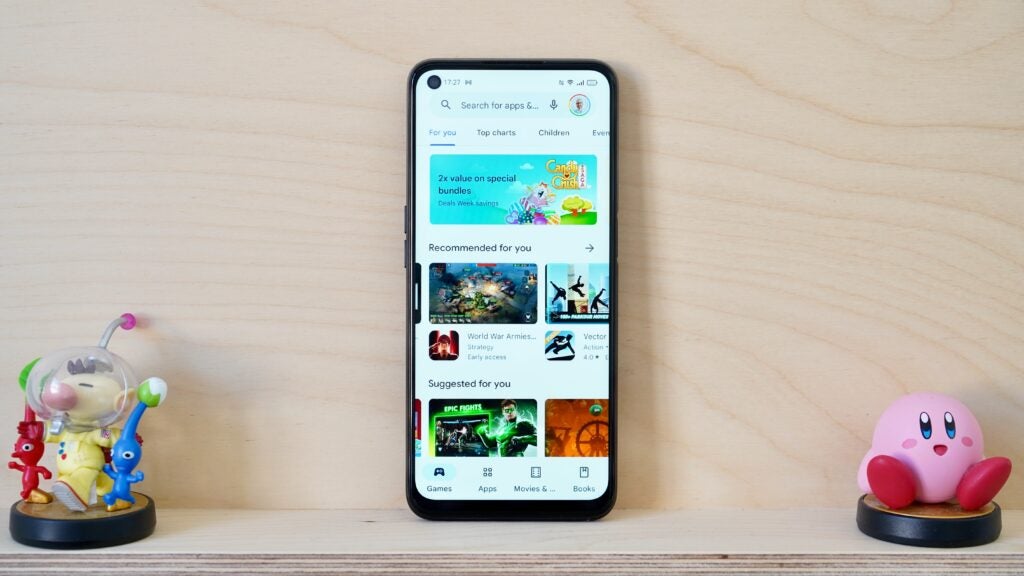
Oppo has equipped its budget phone with a 6.5-inch IPS LCD panel. This is quite clearly the biggest compromise that’s been reached in hitting that 5G target, since the non-5G Oppo A74 released in other territories comes with a vibrant OLED panel.
It isn’t a bad LCD by any means, with a crisp 1080 x 2400 (FHD+) resolution and acceptable 480-nit peak brightness. Another advantage over that 4G model is a 90Hz refresh rate rather than the bog-standard 60Hz.
That’s less of a stand-out feature when the performance potential is as limited as it is here. You’ll never get the full silky advantage of a properly driven higher refresh rate display, but it’s smooth enough in day-to-day use.
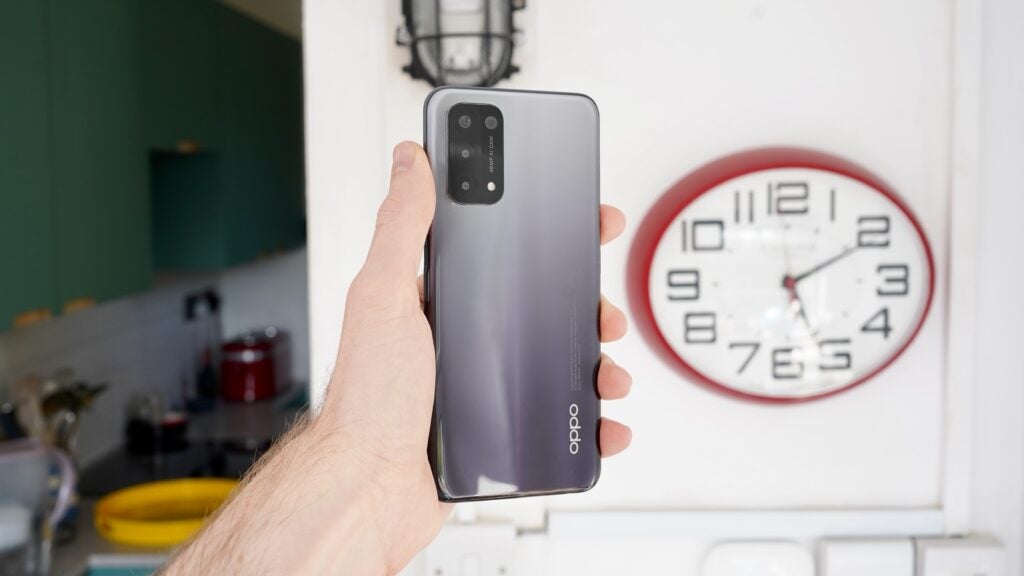
Camera
- 48-megapixel main camera
- 8-megapixel ultra-wide
- 2-megapixel macro and depth sensors
You’re getting a so-called quad camera system in the Oppo A74 5G, but only two of those sensors actually matter. Those are a 48-megapixel wide sensor and an 8-megapixel ultra-wide.
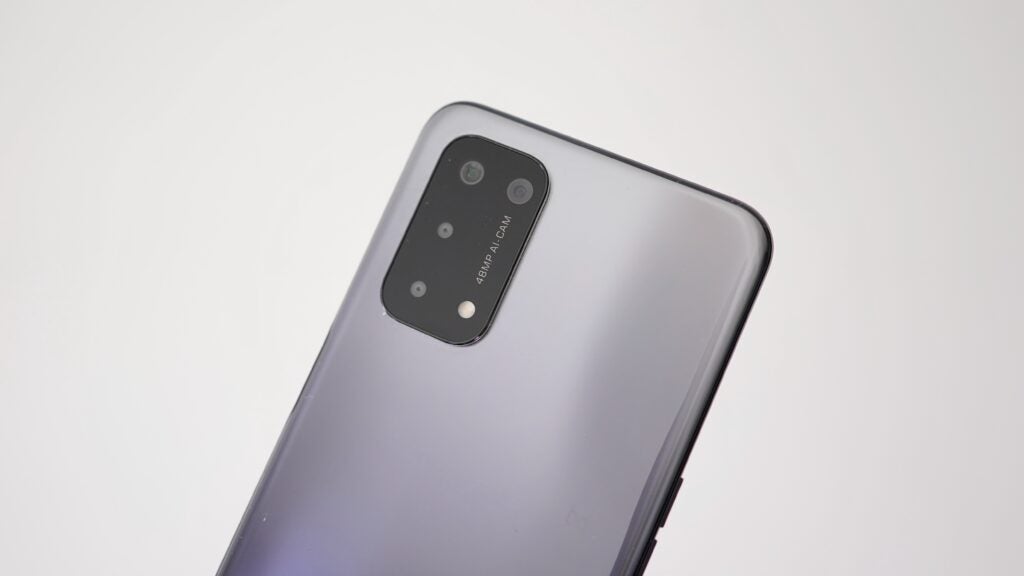
The other two sensors come in at 2 megapixels, and they handle macro and depth duties. They’re largely there to make up the numbers.
I quite enjoyed using the Oppo A74 5G’s main camera outdoors during a sunny week. Oppo’s colours are nice and balanced, without being too garish. Fed with plenty of light, my snaps tended to deliver decent detail.

Inevitably, as soon as the light starts to drop, so too does the quality of the shots. Night mode shots are almost a total write-off, with bags of grain. Just as with the Oppo A54 5G (which is very similar to the Oppo A54 5G, in many ways), it’s one of the worst night-time performers in its class.
The AI assistant isn’t active by default, as is often the case. When activated, it will brighten up indoor shots quite noticeably. I also discovered that it would apply HDR a little more diligently in such situations.
However, outside in good natural lighting, I found that this AI assistant would overdo the brightening and blow out certain highlights. It made some of the clear skies look a little too blue – albeit more social media-worthy. It’s generally best left off in such scenarios.


The 8-megapixel ultra-wide is quite a limited component by comparison. Shots taken with this sensor looked notably dimmer and murkier than those captured with the main sensor, with much less balance and dynamic range. It’s good to have the option of a wider angle, but you’ll likely find yourself relying on the main sensor for the vast majority of your shots.
There’s no dedicated telephoto camera, so the Oppo A74 5G’s 2x zoom (and beyond) settings rely on cropping in on that main sensor. There are ample pixels to make these usable, but they’re distractingly fuzzy beyond 2x.
There’s a 16-megapixel selfie camera around front, and it’s perfectly adequate in ideal lighting. It kept me in focus against busy backgrounds, with suitably sharp edges distinguishing me from my background – although my skin tone seemed a little smudged and washed out.




Performance
- Snapdragon 480 5G
- 6GB of RAM
- ColorOS 11.1 on Android 11
Just like the aforementioned Oppo A54 5G and the Nokia X10, the Oppo A74 5G runs on Qualcomm’s Snapdragon 480 5G chip. It’s one of the lesser chips in the roster, but it’s sufficient for most day-to-day tasks, and it’s accompanied by a healthy 6GB of RAM.
That’s reflected in a Geekbench 5 single-core score of 518, which establishes clear space between this and entry-level phones such as the Moto G22 in regular running. Meanwhile, a multi-core score of 1722 is similarly comfortable, if far short of mid-priced phones such as the OnePlus Nord 2T.
Both scores place the Oppo A74 5G roughly equal to the more recent Poco M4 Pro 5G with its MediaTek Dimensity 810 5G chip. It falls a little short of the Realme 9 5G with its Snapdragon 695 and the OnePlus Nord N10 5G with its Snapdragon 680, however.
In GPU terms, the Oppo A74 scored better than rival the OnePlus Nord N10 5G, with a 3DMark Sling Shot Extreme score of 2408 and a Wild Life score of 977. In practical terms, I was able to run Genshin Impact on Medium graphical settings at 60fps, and it remained playable, if not perfectly smooth.
When it comes to the Oppo A74’s software, it currently runs ColorOS 11.1 on top of Android 11. ColorOS itself is fairly inoffensive as Android skins go.
Its menus are moderately clean and unobtrusive, with not even a Google Feed screen or an app tray to distract you from the homescreen. It isn’t as sharp or appealing as stock Android, but it works well at showing you what’s important, making it a decent first smartphone experience.
Most of Oppo’s own apps are bundled into a discrete Tools folder, although there are still home-brewed apps for Videos, Music, File manager and the like. You’ll have to put up with third-party pre-installations such as Facebook, Amazon Shopping, and Amazon Music, which is a little irritating; but we’ve seen much (much) worse.
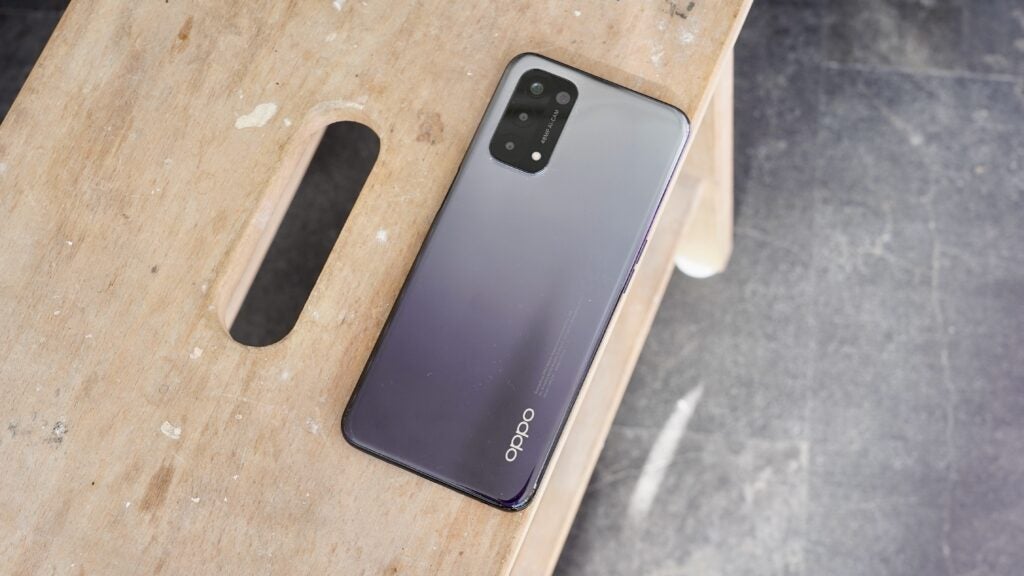
Battery Life
- 5000mAh battery
- Good for a full day of fairly heavy use
- Slow 18W charger
The Oppo A74 5G packs a 5000mAh battery, which is almost a standard spec at this end of the market. Like most of its rivals, it will get you through a full day of fairly heavy use without issue – and potentially two full days of light use.
Following a 16-hour day of moderate use, totalling three hours of screen-on time, I was left with just over 60% in the tank. That’s pretty good going, although far from an outlier.
An hour of Netflix streaming sapped 8% of a full charge. That’s the same as the Poco M4 Pro 5G, the Nokia X20, and many other contemporary Android phones.
In recharging terms, Oppo has bundled its phone with an 18W charger. This may be a notable advance over the Oppo A54 5G’s pitiful 10W provision, but it falls well short of the 33W charger included with many Poco and Redmi-branded rivals, as well as the 30W charger that was bundled with the OnePlus Nord N10 5G.
This leads to some less than stellar charging times. I found that going from completely empty to 50% took 45 minutes, while going from empty to completely full took just over 2hrs 15mins. It’s best suited to overnight charging.
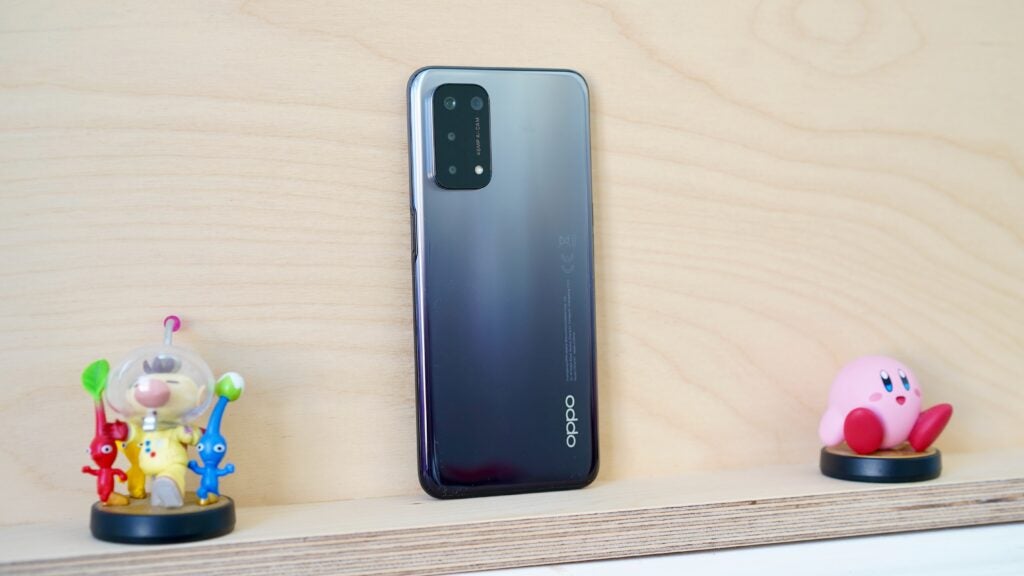
Should you buy it?
You want 5G for less than £250 If a speedy network connection is a must, but you’re on a strict budget, then the Oppo A74 5G is another solid option.
You want a phone that charges fast. With a mere 18W charger in the box, the Oppo A74 5G charges up much slower than some of its contemporaries.
Final Thoughts
The Oppo A74 5G is another highly competent budget phone from this reliable brand, but it doesn’t really do anything to stand out in a competitive field. It provides a well-balanced package with 5G connectivity and a design that’s tame and plasticky, but nonetheless solid.
However, that cutting-edge network connectivity comes with the usual degree of compromise in the form of a fairly bog-standard (if far from bad) LCD rather than OLED screen. Performance is just about good enough, but gamers can do better for the money.
Elsewhere the phone holds its own on battery life, but the provision of an 18W charger can’t quite match some of its affordable rivals.
All in all, you might find that you can get more for your money with one of Xiaomi’s value-focused sub-brands. As always, though, the main question you should ask yourself is how much you actually need 5G connectivity, because similarly priced 4G phones are often better.
FAQs
This phone does not have an IP rating, which isn’t surprising given its price.
Jargon buster
USB-C
The modern USB connector you’ll find on most Android phones, new laptops, cameras and games consoles. It’s reversible and used for charging along with data-transfer.
Refresh Rate
The number of times the screen refreshes itself per second.
OLED
OLED stands for Organic Light Emitting Diode. It’s a display made up of self emissive pixels, each of which can create its own light. A bright pixel can sit next to a dark pixel to help create deep black levels and high contrast beyond that of traditional displays. The lack of a backlight also means these displays can be thinner than other types of TVs.
5G
Offering faster download and upload speeds when compared to 4G. Great for game streaming and HDR video playback. Not supported everywhere yet and speeds vary wildly.
















